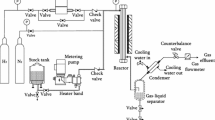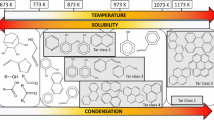Abstract
NOx emission is a serious problem during fossil fuel combustion. Novel reburning fuels, namely, nitrogen-containing tar compounds, including pyridine and pyrrole were taken into consideration for NO reduction and investigated by quantum chemical method. Theoretical calculation results show that pyridine could first decompose into small species, such as CN and hydrocarbon radicals, then reduce NO to N2. The decomposition of pyridine should overcome quite high energy barrier and adsorb a large amount of heat. This pathway may occur at high temperature zone, such as core flame zone of pulverized coal fired boiler. As soon as pyridine decomposes, the active intermediates (CN radical, etc.) could reduce NO very quickly. The direct reduction of NO by pyridine molecule should overcome lower energy barrier, which could occur at wider temperature range. Pyrrole is less thermostable than pyridine; the energy barriers of pyrrole cracking and direct reduction of NO stay at same level. Therefore, the reburning efficiency of pyrrole may be better at lower temperature than pyridine. Theoretical calculations indicate that nitrogen-containing tar compounds produced during biomass pyrolysis/gasification could have good performance for NO reduction in pulverized coal fired boiler as well as biomass or MSW furnace.

Graphical abstract






Similar content being viewed by others
References
Wendt JO, Sternling C, Matovich M (1973) In Reduction of sulfur trioxide and nitrogen oxides by secondary fuel injection, Symposium (International) on Combustion. Elsevier: pp. 897–904
Smoot LD, Hill S, Xu H (1998) NOx control through reburning. Prog Energy Combust Sci 24(5):385–408
Patry M, Engel G (1950) Formation of HCN by the action of nitric oxide on methane at atmospheric pressure, 1. General conditions of formation. Compt Rend 231:1302–1304
Harding NS, Adams BR (2000) Biomass as a reburning fuel: a specialized cofiring application. Biomass Bioenergy 19(6):429–445
Adams B, Harding N (1998) Reburning using biomass for NOx control. Fuel Process Technol 54(1–3):249–263
Zhuang H, Niu Y, Gong Y, Zhang Y, Zhang Y, Hui S (2017) Influence of biomass Reburning on NO x reductions during pulverized coal combustion. Energy Fuel 31(5):5597–5602
Baxter LL (1993) Ash deposition during biomass and coal combustion: a mechanistic approach. Biomass Bioenergy 4(2):85–102
Duan J, Luo Y-H, Yan N-Q, Chen Y (2007) Effect of biomass gasification tar on NO reduction by biogas reburning. Energy Fuel 21(3):1511–1516
Blander M (1999) Biomass gasification as a means for avoiding fouling and corrosion during combustion. J Mol Liq 83(1–3):323–328
Han Z, Zeng X, Yao C, Wang Y, Xu G (2016) Comparison of direct combustion in a circulating fluidized bed system and decoupling combustion in a dual fluidized bed system for distilled spirit lees. Energy Fuel 30(3):1693–1700
Dagaut P, Luche J, Cathonnet M (2000) The kinetics of C1 to C4 hydrocarbons/NO interactions in relation with reburning. Proc Combust Inst 28(2):2459–2465
Etzkorn T, Muris S, Wolfrum J, Dembny C, Bockhorn H, Nelson P, Attia-Shahin A, Warnatz J (1992) In Destruction and formation of NO in low pressure stoichiometric CH4/O2 flames, Symposium (International) on Combustion, 1992, Elsevier, pp. 925–932
Bilbao R, Alzueta MU, Millera A, Prada L (1997) Dilution and stoichiometry effects on gas reburning: an experimental study. Ind Eng Chem Res 36(6):2440–2444
Bilbao R, Alzueta MU, Millera A (1995) Experimental study of the influence of the operating variables on natural gas reburning efficiency. Ind Eng Chem Res 34(12):4531–4539
Bilbao R, Millera A, Alzueta MU, Prada L (1997) Evaluation of the use of different hydrocarbon fuels for gas reburning. Fuel 76(14–15):1401–1407
Dagaut P, Lecomte F (2003) Experiments and kinetic modeling study of NO-reburning by gases from biomass pyrolysis in a JSR. Energy Fuel 17(3):608–613
Dagaut P, Lecomte F, Chevailler S, Cathonnet M (1999) Experimental and kinetic modeling of nitric oxide reduction by acetylene in an atmospheric pressure jet-stirred reactor. Fuel 78(11):1245–1252
Dagaut P, Lecomte F, Chevailler S, Cathonnet M (1999) The reduction of NO by ethylene in a jet-stirred reactor at 1 atm: experimental and kinetic modelling. Combust Flame 119(4):494–504
Dagaut P, Luche J, Cathonnet M (2001) Reduction of NO by propane in a JSR at 1 atm: experimental and kinetic modeling. Fuel 80(7):979–986
Evans RJ, Milne TA (1997) Chemistry of tar formation and maturation in the thermochemical conversion of biomass. In: Developments in thermochemical biomass conversion. Springer, pp 803–816
Wu Y, Yin W, Yang S, Chang-bin Y, Yue-jin L, Guang-wen X (2013) NO reduction characteristics of biomass pyrolysis products in a drop-tube reactor. Chin J Process Eng 2
Bae SW, Roh SA, Kim SD (2006) NO removal by reducing agents and additives in the selective non-catalytic reduction (SNCR) process. Chemosphere 65(1):170–175
Sendt K, Bacskay GB, Mackie JC (2000) Pyrolysis of furan: Ab initio quantum chemical and kinetic modeling studies. J Phys Chem A 104(9):1861–1875
Liu C-y, Yin R-h, Zhang R-z, Luo Y-h (2012) Experimental and kinetic study of NOx reduction by reburning using syngas from updraft biomass gasification with phenol as a model compound for tar. Energy Fuel 26(6):3739–3746
Bunman Y, Do H-S, Zeng X, Han Z, Gao S, Xu G (2018) NO reduction by different tar agents and model compounds in a drop-tube reactor. Fuel Process Technol 172:187–194
Miller JA (1996) Theory and modeling in combustion chemistry. Sandia National Labs. Albuquerque, NM (United States)
Haworth NL, Mackie JC, Bacskay GB (2003) An ab initio quantum chemical and kinetic study of the NNH+ O reaction potential energy surface: how important is this route to NO in combustion? J Phys Chem A 107(35):6792–6803
Montoya A, Truong TN, Sarofim AF (2000) Application of density functional theory to the study of the reaction of NO with char-bound nitrogen during combustion. J Phys Chem A 104(36):8409–8417
Zhang H, Liu J, Liu J, Luo L, Jiang X (2018) DFT study on the alternative NH3 formation path and its functional group effect. Fuel 214:108–114
Becidan M, Skreiberg Ø, Hustad JE (2007) NO x and N2O precursors (NH3 and HCN) in pyrolysis of biomass residues. Energy Fuel 21(2):1173–1180
Chen H, Wang Y, Xu G, Yoshikawa K (2012) Fuel-N evolution during the pyrolysis of industrial biomass wastes with high nitrogen content. Energies 5(12):5418–5438
Zhu X, Yang S, Wang L, Liu Y, Qian F, Yao W, Zhang S, Chen J (2016) Tracking the conversion of nitrogen during pyrolysis of antibiotic mycelial fermentation residues using XPS and TG-FTIR-MS technology. Environ Pollut 211:20–27
Zhan H, Zhuang X, Song Y, Yin X, Wu C (2018) Insights into the evolution of fuel-N to NOx precursors during pyrolysis of N-rich nonlignocellulosic biomass. Appl Energy 219:20–33
Yu Q, Brage C, Chen G, Sjöström K (2007) The fate of fuel-nitrogen during gasification of biomass in a pressurised fluidised bed gasifier. Fuel 86(4):611–618
Ping-ge D, Zhang L-g, Cheng-cheng J (2012) The influence of pyrolysis temperature on the component of biomass pyrolytic tar. Renew Energy Resour 5
Zhang X, Zhou Z, Zhou J, Jiang S, Liu J, Cen K (2011) Analysis of the reaction between O2 and nitrogen-containing char using the density functional theory. Energy Fuel 25(2):670–675
Zhao T, Song W, Fan C, Li S, Glarborg P, Yao X (2018) Density functional theory study of the role of an carbon–oxygen single bond group in the NO–char reaction. Energy Fuel 32(7):7734–7744
Zhang X, Zhou Z, Zhou J, Liu J, Cen K (2012) Density functional study of NO desorption from oxidation of nitrogen containing char by O2. Combust Sci Technol 184(4):445–455
Becke AD (1993) Density-functional thermochemistry. III. The role of exact exchange. J Chem Phys 98(7):5648–5652
Becke AD (1992) Density-functional thermochemistry. I. the effect of the exchange-only gradient correction. J Chem Phys 96(3):2155–2160
Becke AD (1992) Density-functional thermochemistry. II. The effect of the Perdew–Wang generalized-gradient correlation correction. J Chem Phys 97(12):9173–9177
Patterson JM, Tsamasfyros A, Smith WT Jr (1968) Pyrolysis of pyrrole. J Heterocyclic Chem 5(5):727–729
Lifshitz A, Tamburu C, Suslensky A (1989) Isomerization and decomposition of pyrrole at elevated temperatures: studies with a single-pulse shock tube. J Phys Chem 93(15):5802–5808
Houser TJ, McCarville ME, Biftu T (1980) Kinetics of the thermal decomposition of pyridine in a flow system. Int J Chem Kinet 12(8):555–568
Mackie JC, Colket MB, Nelson PF (1990) Shock tube pyrolysis of pyridine. J Phys Chem 94(10):4099–4106
Memon H, Bartle K, Taylor J, Williams A (2000) The shock tube pyrolysis of pyridine. Int J Energy Res 24(13):1141–1159
Mackie JC, Colket MB III, Nelson PF, Esler M (1991) Shock tube pyrolysis of pyrrole and kinetic modeling. Int J Chem Kinet 23(8):733–760
Axworthy AE, Dayan VH, Martin GB (1978) Reactions of fuel-nitrogen compounds under conditions of inert pyrolysis. Fuel 57(1):29–35
Mulvihill JN, Phillips LF (1975) In Breakdown of cyanogen in fuel-rich H2/N2/O2 flames, Symposium (International) on Combustion, 1975. Elsevier, pp. 1113–1122
Martoprawiro M, Bacskay GB, Mackie JC (1999) Ab initio quantum chemical and kinetic modeling study of the pyrolysis kinetics of pyrrole. J Phys Chem A 103(20):3923–3934
Dagaut P, Lecomte F, Chevailler S, Cathonnet M (2000) The oxidation of HCN and reactions with nitric oxide: experimental and detailed kinetic modeling. Combust Sci Technol 155(1):105–127
Li Y, Li Y, Wang P, Hu W, Zhang S, Shi Q, Zhan S (2017) Low-temperature selective catalytic reduction of NOx with NH3 over MnFeOx nanorods. Chem Eng J 330:213–222
Halbgewachs MJ, Diau EWG, Mebel AM, Lin MC, Melius CF (1996) Thermal reduction of NO by NH3: Kinetic modeling of the NH2+NO product branching ratio. Symp Combust 26(2):2109–2115
Funding
This work was supported by Science Foundation of Nanjing Institute of Technology (YKJ201813).
Author information
Authors and Affiliations
Corresponding author
Additional information
Publisher’s Note
Springer Nature remains neutral with regard to jurisdictional claims in published maps and institutional affiliations.
Rights and permissions
About this article
Cite this article
Zhao, S., Chen, L., Bi, X. et al. Thermodynamic and kinetic study of NO reduction by pyridine/pyrrole during biomass tar reburning: the quantum chemical method approach. Biomass Conv. Bioref. 12, 5937–5946 (2022). https://doi.org/10.1007/s13399-020-01036-x
Received:
Revised:
Accepted:
Published:
Issue Date:
DOI: https://doi.org/10.1007/s13399-020-01036-x




